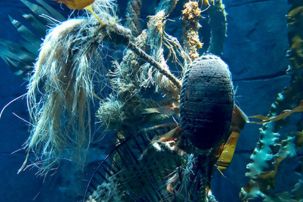Lesson summary
In this activity students conduct a simple experiment to determine the decomposition rates of three different types of waste that are commonly found in the ocean. Students will test the waste over several months in both fresh and salty water.
Learning intentions:
Students will...
- learn that waste has a huge impact on marine environments.
- understand that disposing of waste appropriately can help marine biodiversity considerably.
Lesson guides and printables
Lesson details
Curriculum mapping
Australian curriculum content descriptions:
Year 5 Science:
- With guidance, plan appropriate investigation methods to answer questions or solve problems (ACSIS086)
- Decide which variable should be changed and measured in fair tests and accurately observe, measure and record data, using digital technologies as appropriate (ACSIS087)
- Compare data with predictions and use as evidence in developing explanations (ACSIS218)
- Suggest improvements to the methods used to investigate a question or solve a problem (ACSIS091)
- Communicate ideas, explanations and processes in a variety of ways, including multi-modal texts (ACSIS093)
Year 6 Science:
- With guidance, plan appropriate investigation methods to answer questions or solve problems (ACSIS103)
- Decide which variable should be changed and measured in fair tests and accurately observe, measure and record data, using digital technologies as appropriate (ACSIS104)
- Compare data with predictions and use as evidence in developing explanations (ACSIS221)
- Suggest improvements to the methods used to investigate a question or solve a problem (ACSIS108)
- Communicate ideas, explanations and processes in a variety of ways, including multi-modal texts (ACSIS110)
Syllabus Outcomes: ST3-4WS.
Time required: 60 mins, this experiment will take several months and can be revisited at several points during this time.
Level of teacher scaffolding: High – assist students with experiment.
Resources required
Each group will need the following items:
- 2 buckets of water
- Salt
- 2 items of 3 different types of waste (see list in Teacher or Student worksheets)
- Student worksheet
Additional info
Following this lesson plan is an ideal way for your school to introduce Zoos Victoria’s Seal the Loop program. You’ll be joining other amazing teachers in making a difference and creating positive environmental change. Go to Zoo Education Online to find further support for you to help you develop your own Seal the Loop program.


Welcome back!
Don't have an account yet?
Log in with:
By signing up to Cool.org you consent and agree to Cool's privacy policy to
store, manage and process your personal information. To read more, please see
our privacy policy here(Opens in new tab).
Create your free Cool.org account.
Many of our resources are free, with an option to upgrade to Cool+ for premium content.
Already have an account?
Sign up with:
By signing up to Cool.org you consent and agree to Cool's privacy policy to
store, manage and process your personal information. To read more, please see
our privacy policy here(Opens in new tab).